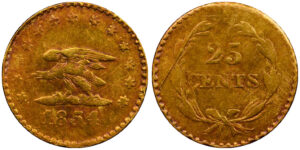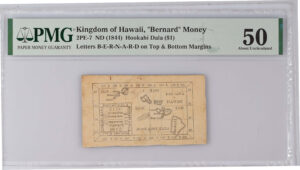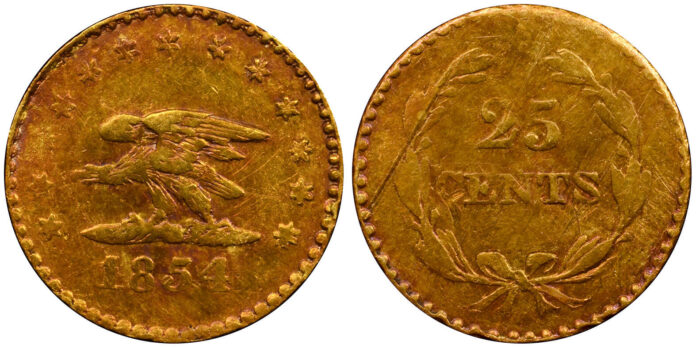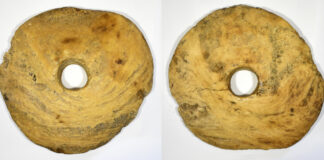Traditional, Odd & Curious Money at Kagin’s
From 11th to 12th March 2021 Kagin’s is holding their March 2021 Auction in San Francisco Bay. The auction offers many rarities mainly from four big collections: the William C. O’Connor, the Charles J. Opitz, the Joe Usibelli and the Aloha Hawaiian Collection.

William C. O’Connor Collection
On 11th March 2021, Kagin’s will sell at auction the entire collection of William C. O’Connor (1927-2009, ANA 90358), a noted specialist in Period One California fractional gold coins; he formed a close second to the most-complete collection of Period One California Fractional Gold, as determined by PCGS, with 124 out of 142 possible varieties – including three recognized as unique. This auction will be held in the San Francisco Bay area due to the cancellation of the National Money Show.
Other rarities include the Defiant Eagle 25 cents of 1854, the Arms of California half dollar of 1853, four round dollars (plus a round dollar of 1871), seven different G.G. pieces, and many important and unusual varieties. Each has been certified by PCGS in a special holder pedigreed to William C. O’Connor.
Every coin has been attributed to the Breen-Gillio catalog, California Pioneer Fractional Gold, second edition, by both type number and die state. Because the collection is so complete, extensive notes on die variety and manufacturer have been included, making the catalog a lasting reference.
Mr. O’Connor took up this fascinating series in the mid-1970s, joining the ANA in 1976. He was most active from then through the early 1990s, but was still adding to his collection in 2003. He spent many weekends traveling to coin shows in the Midwest, searching for new varieties, but also bought from leading dealers and bid in major auctions by telephone. He loaned pieces missing in the first edition of Breen-Gillio for photography; they are plate coins in the second edition. He also read the manuscript for Period One (1852-1857) for this edition, making important comments.
It seems as though about a decade or so passes between auctions of great lifetime collections in this series: in 1988, it was the Kenneth Lee Collection; in 2003, the Jay Roe Collection; in 2013, the Jack Totheroh Collection; and now, on 11th March 2021, the William C. O’Connor collection. Specialists should take note.

Charles J. Opitz Reference Collection Of Traditional and Odd & Curious Money
On 12th March the “Reference Collection” will follow. This was the collection of Charles J. Opitz, author of An Ethnographic Study of Traditional Money and other references on primitive and Odd & Curious Money. Mr. Opitz personally selected highlights of his comprehensive collection, including many examples illustrated in his first edition or a later edition available on the Newman Numismatic Portal. Over 500 lots have been cataloged.
Three Yap stones, including a huge 78 lb., giant, are included. Another rarity is a Grade 1 Santa Cruz feather coil, straight from the makers. Also present are two examples of 19th-century Borneo cannon money, used in Brunei, Sabah, and Sarawak for trading and payment of fines. Three moko drums, used as money on Alor Island, are included, as well as a fine kyee-zee gong from Burma. Africa is well represented by a zappozap, a Uganda marriage hoe, and a huge coiled manilla, among others. Asia supplies a rare original dZi bead of desirable pattern.
Besides these famous pieces, a beaded jacket of the Atayal Tribe of Taiwan with over 50,000 handmade beads and worth fine cattle or several wives, will appear at auction for the first time since 1992. Swedish plate money in denominations from ½ to 4 daler, a piece of California Clamshell Money, and some New England wampum are also present.
Nearly every lot has been off the market for decades. Though all continents are represented, the collection is particularly rich in the traditional money of the South Seas and New Guinea, many collected by Mr. Opitz personally on his visits there, beginning in 1973. Others were found in collections purchased by him; many are very rare.
A number of items are pedigreed to the famous Howard Gibbs Collection; Mr. Gibbs was very aggressive in securing examples of these perishable currencies at the time they were still in use.

Finest Collection of Alaskan Russian-American “Walrus Skin” Money
Believed to be the finest collection of Alaskan Russian-American “walrus skin” money is being offered on 11th and 12th March. The Joe Usibelli Collection of six of these rare notes, plus an additional note includes some of the finest examples of these early and mid-19th century banknotes. The offering is tied for the third largest ever.
Highlights include 10 Kopecks PMG NEW-61 Ex: John J. Ford, Jr. Collection; 25 Kopecks PMG NEW-62; 50 Kopecks PMG VERY CHOICE NEW-63; one of two known 1 Rouble on aqua-green parchment graded PMG Extremely Fine-40 tear repair Ex: Henry Clifford Collection; and 1 Rouble on mustard colored parchment PMG graded AU-50 Ex: Henry Clifford, John J. Ford, Jr.
Russian-American Company “Walrus Skin” money appeals to U.S. currency collectors, world paper money buyers, Alaskan, California and Russian collectors, and Odd & Curious/ Primitive Money collectors.
As early as 1741 Alaska had become part of Russia’s land holdings and by 1790 the local fur trading industry flourished.
In 1799 Czar Paul I purchased shares in the semi-autonomous Russian-American Company, to monopolize on the trade in Russian America. By 1811 their holdings eventually encompassed parts of California as far south as Fort Ross.
A major aspect of the fur trading Russian-American Company enterprise consisted of shipping otter and seal skins to China in waterproof bags made of walrus leather skins. The bags were reused to wrap shipments of various spices bound for Russian ports. In 1816 select pieces to be cut from the walrus bags and stamped with seven different values including 10, 25, and 50 Kopeks, and 1,5,10 and 25 Roubles to pay colonial employees and facilitated commerce. Other issues were printed in 1822,1826,1834,1842, 1845 and 1852 although according to the cataloger less than 50 of these notes are currently extant.

Rare Hawaiian Currency Featured in Kagin’s Auction
On 12th March “The Aloha Hawaiian Collection” will go on sale including high-grade examples of the earliest and rarest Hawaiian scrip currency. Each note is graded by Numismatic Grading Corporation and listed in Hawaiian Money by Donald Medcalf and Ronald Russell.
Hawaii’s sugar industry started in 1835 on the Island of Kauai. Ladd & Company signed a lease with King Kamehameha III and issued scrip in 1837 to pay workers. The company went bankrupt and the Government seized their assets. The finer of just two reported known notes, a PMG CU-63 $1/8th HAPAWALU 2PE-1 last sold in the Superior 2/75 sale of the incomparable A.J. Ostheimer Collection begins the offering.
The 1844 WAILUKU FEMALE SEMINARY 1 HAPAUMI (approx. 10 cent) note is another seldom seen or offered note. The Seminary opened July, 1837 in Wailuku, Maui and was dedicated to teaching domestic arts to native girls. Missionaries imported a printing press to Honolulu in 1820 and in 1833 the press was shipped to the Lahainaluna Seminary. At the time there was an acute shortage of coins to pay the male employees so in 1844 they printed scrip in red on thin cardboard. The finest of only 5-6 known, graded PMG CU-63, is part of the Aloha Collection.
An additional $200 of these notes were made to order for sugar manufacturer, Edward Bailey and were counter-stamped “Edward Bailey”. A PMG VF-35 specimen is in the unreserved auction. Both notes are extremely rare.
Highlighting this collection is the Unique 1844 “Bernard” Money note which according to the cataloger, is its only public appearance in over a half century. John Bernard, and Englishman, Godfrey Rhodes, leased 150 acres of land in Hanalei, Kauai, from the Hawaiian Government. Like Bailey, Bernard had $850 worth of notes printed by the Lahainaluna Seminary who counter-stamped “Bernard” on them. A single known AU-50 HOOKAHI DOLLAR is offered.
A six-note set of LAHAINALUNA SEMINARY CURRENCY is offered provisionally in six lots and then as a single lot. It is believed by the cataloger to possibly be the finest known cut sheet.
All lots of the auction can be viewed online. More information on online bidding can be found on Kagin’s website.




